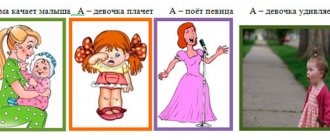Hello, dear visitors of our site!
In this article I would like to consider such an important topic as phonemic hearing. This topic is very important, since phonemic hearing is one of the foundations involved in the formation and development of speech in our children.
To begin with, we will define what phonemic hearing is, when and how phonemic hearing is formed, then we will find out how phonemic hearing affects the formation of a child’s speech, and also consider ways to develop phonemic hearing.
What is phonemic awareness
In modern pedagogical, psychological and methodological literature, different terms are used to refer to phonemic hearing: speech hearing, speech perception, phonemic hearing and phonemic perception.
Phoneme (from Greek - sound) is the minimum sound unit of oral speech (in other words, a speech or audible sound (for example: a, o, y, v, p, l, r, w, etc.). This is precisely the audible sound (although we not only hear sounds, but also pronounce them, and also represent them in our minds and graphically represent them in the form of letters). Phonemes serve to construct and distinguish significant units of language: morphemes, words, sentences (in other words, combining into a series of sounds, sounds or phonemes are transformed into syllables, words and sentences, and due to a certain set of sounds a person distinguishes one morpheme, word, sentence from other morphemes, words and sentences (for example: fly, flour, hand...). Thus, when the set changes phonemes change and the meaning of what is said and heard.
Phonemic hearing is the ability to isolate (perceive and distinguish) individual speech sounds in a speech stream. This ability ensures understanding of the meanings of words, because thanks to phonemic analysis and synthesis, the composition and sequence of phonemes is established orally (in this case, the sound composition is often written in letters). (Compare: Masha waves. Misha waves. Pasha plows.).
Phonemic perception (a similar concept to phonemic hearing) is the ability, based on auditory impressions, to create holistic auditory ideas about the sounds of speech and to distinguish sounds from each other. A child has normal physiological hearing, but his phonemic hearing may be impaired, which disrupts the perception of a given language (understanding of what he hears and what he reads). Speech hearing is a component of sound sense.
Without speech hearing, speech communication is impossible.
Why is it necessary to develop it?
Without understanding the sound features of the speech of others, it will be difficult for a child to learn to speak. With developed phonemic hearing, the baby realizes that he is pronouncing the word incorrectly and tries to independently achieve the correct pronunciation. If the difference between similar sounds is not caught, stable substitutions “beetle - kuk”, “shishka - detective” are formed. The worse the phonemic hearing is developed, the more pronounced the speech problems. In such cases, they say that children feel like they have porridge in their mouth.
If a problem is not solved in preschool age, many new, much more serious ones arise from it. The child has difficulty reading, writing, and learning other languages. He has difficulty merging syllables, isolating individual sounds, he writes endings incorrectly, and much more. Schoolchildren begin to fall seriously behind in their school curriculum.
When and how is phonemic hearing formed?
A child’s phonemic hearing begins to develop very early. Normally, it is formed spontaneously - before the child enters school (in its simple form), and then in the process of learning to read and write, a more complex form is formed.
Phonemic hearing is formed in children by perceiving the speech of others and by their own pronunciation.
Mastery of the sound side of speech and direct sound discrimination occurs gradually and has a consistent pattern.
Below is a table that reflects the sequence of formation of speech hearing and perception. I wanted to emphasize that
The indication of the age period is approximate, because one way or another it is necessary to take into account the characteristics of the child’s individual development.
Table. Formation of phonemic hearing
| Child's age | Opportunities, skills, abilities of the child |
| at 2 weeks | A child, hearing the sound of a human voice, stops sucking at his mother's breast and stops crying when they start talking to him. |
| by the end of 1 month | The baby calms down to the sound of a lullaby. |
| by the end of 3 months | The baby turns his head towards the speaker and follows him with his eyes. |
| 4 -6 months | The child learns the intonation component of speech. Reacts adequately to intonation. Recognizes familiar voices. |
| from 6 months | This is the period of babbling. The child repeats the visible articulation of the adult’s lips and tries to imitate. Repeated repetition of the kinesthetic sensation from a certain movement leads to the consolidation of a motor skill - articulation. By imitation, the child pronounces individual phonemes (speech sounds), syllables, and adopts the tone, melody and intonation of speech. Understands specific instructions in a specific situation and obeys certain verbal commands ( Give me a pen. It is forbidden. ) |
| 6 – 12 months | The child learns the rhythmic aspect of speech, as well as the tempo of speech. |
| from 10 – 18 months | The ability to perceive the sound composition of a word develops (this is phonemic hearing). Understands the names of individual objects. Then he begins to recognize them in pictures. Later he finds them in the plot pictures. |
| 20 – 24 months | Understands the actions indicated in the pictures and follows instructions (Show me who's sleeping. Show me who's eating) follows two-step instructions ( |
| by 2 years | Children distinguish all the subtleties of their native speech, understand and respond to words that differ in just one phoneme (kashka - helmet ) |
| 2 - 3 years | Comprehension of short stories and fairy tales read (first with the support of a picture, and then without support). Vowels and consonants that are simple in articulation are fixed in pronunciation: A, O, U, E, I, Y, K-G-H, K-G-H-H, M-P-B, M-P-B, T-D -N,T-D-N, L,S (sounds of early ontogenesis). |
| by 3 - 4 years | The child’s phonemic perception improves so much that he begins to differentiate (distinguish) first vowels and consonants, then soft and hard consonants, sonorant (P, Rb, L, L, N, Нь, М, Мь, И), hissing (Ш, Ж). , Ш, Ш) and whistling (С, Сь, З, Зь, Ц). As speech experience progresses, the child learns to distinguish sounds that are closer acoustically and articulatory (S - Ts, Sb - Shch, Th - Ch, Sh - Shch, Ts - Ch, S - Ch - Sh, etc.). The child increasingly develops the skill of auditory control over his pronunciation and the ability to correct it in some cases. Understands the meaning of prepositions outside the usual specific situation. Understands complex sentences. Listens to long stories and fairy tales. Understands and follows two-step instructions. |
| by 4 years | By this age, phonemic hearing has already been formed. Normally, it differentiates (distinguishes) all sounds. |
| 4-5 years | As speech experience, articulation skills and phonemic hearing develop, the child begins to pronounce more complex sounds: S, Z, Ts, Sh, Zh, Ch, Shch, L, R, Rb (sounds of late ontogenesis). |
| 5-6 years | The child is completing the formation of correct sound pronunciation. The child's speech experience is growing. The child’s speech abilities are improving. The skill of auditory control over your pronunciation and the ability to correct it in some cases becomes even more subtle. Speech hearing is a component of the linguistic sense. Due to which he correctly understands and correctly agrees the possessive pronoun and noun (M oh doll. My umbrella. My skis) a noun with an adjective in number, gender, case |
| from 6 years old | In the process of learning to read and write, a more complex form of phonemic analysis and synthesis is formed. A child can isolate a sound in a word, determine the number and sequence of sounds in a word, and characterize each sound according to the accepted rules of his native language. |
The process of mastering sound pronunciation is individual in nature (both in time and in the use of strategies and the sequence of sound acquisition).
But it can still be noted that stop consonants are usually acquired before fricative ones, voiceless ones before voiced ones, soft ones before hard ones, and whistling ones before sibilants. Moreover, at first children learn not those sounds that they clearly perceive by ear, but those that are easier for them to pronounce. Earlier, children begin to pronounce sounds, the articulation of which corresponds to reflex reactions: breathing, sucking, swallowing, screaming. Then children master sounds that differ from reflex reactions. They are more complex and require additional effort. They are absorbed gradually and are initially replaced by others. What is normal up to 4-5 years (physiological or functional impairment of sound pronunciation).
Probable Causes
The development of phonemic hearing is influenced by the upbringing environment, the example of speech in the family, the state of the peripheral nervous system, etc.
Among the most likely causes of the violation are the following:
- pedagogical neglect;
- hearing loss;
- head injuries, hearing and speech pathologies;
- hyperactivity;
- weakening of the body, serious or frequent illnesses, especially at an early age;
- diseases of the thyroid gland and digestive organs;
- neurological disorders.
To identify the exact cause, it is necessary to consult an ENT specialist, neurologist and speech therapist as early as possible. Sometimes, in addition to the development of phonemic hearing, drug or surgical treatment is required: cutting the hypoglossal ligament, taking central nervous system stimulants.
Phonemic hearing is very important for the development of correct speech. It is necessary not to miss the moment and pay due attention to it at the age of 4–6, so that the child learns easily at school and does not face ridicule from his peers. It is better if the method of hearing development is developed individually, taking into account all the characteristics of the baby.
Phonemic hearing influences the formation of a child’s speech
Along with lexical and grammatical skills, phonemic hearing and correct sound pronunciation are the basis for the formation of skills that ensure the success of speech activity, i.e., full communication.
In turn, phonemic hearing influences the formation of a child’s speech, both oral and then written.
Let's consider the influence of phonemic hearing on the development of oral speech (correct perception of spoken speech, understanding of speech information perceived by ear (for example: fairy tales, stories), as well as the formation of correct sound pronunciation and accurate reproduction of one’s own speech information).
There are many reasons for incorrect pronunciation of sounds.
One of the reasons is the low level of development of phonemic hearing (may have a primary and secondary level).
The formation of correct sound pronunciation depends on the child’s ability to analyze and synthesize speech sounds (the ability to determine the presence of sounds, the number of sounds, their sequence in a phonemic segment, the ability to characterize each sound), i.e., on the level of development of phonemic hearing, which ensures the perception of phonemes of a given language .
Phonemic perception of speech sounds occurs during the interaction of auditory and kinesthetic stimuli entering the cortex. Gradually, these stimuli are differentiated and it becomes possible to isolate individual phonemes. In this case, primary forms of analytical-synthetic activity play an important role, thanks to which the child generalizes the characteristics of some phonemes and distinguishes them from others.
With the help of analytical-synthetic activity, the child compares his imperfect speech with the speech of his elders and forms sound pronunciation. The lack of analysis and synthesis affects the development of pronunciation as a whole.
So, for example, distorted pronunciation of a sound, and especially replacement with other sounds, is accompanied by insufficient discrimination of sounds that are similar in articulation or acoustic characteristics: voiced sounds are replaced by voiceless ones (Zh-Sh, Z-S), hard ones - with soft ones (L-L, S-Sb ...), whistling - hissing (S-SH, Z-ZH, S-SH, S-CH) (saro - lard, sapka - hat, wampa - lamp), instead of two or more articulatory close sounds, a middle, indistinct sound is pronounced ( Ш, С to Ш), etc. The absence of a sound in a word or a violation of the sound filling of a word may be a consequence of the fact that the child cannot determine the presence of a sound in a word (cat - mole, vaenki - felt boots, tsetoik - flower). Also in oral speech, a violation of the syllabic structure can be observed (even in the case if all the sounds included in the word are pronounced correctly), when the child rearranges sounds and syllables or adds others, replaces them with others (katil - tablecloth, siped - bicycle, psiptsy - chips, cafenka - candy). Moreover, a child can pronounce the same word differently in different contexts or when pronounced again. This occurs due to the fact that the child does not grasp the sound content of the word and the sequence of sounds in the word.
Children have general slurred speech and unclear diction. Some delay in the formation of vocabulary and grammatical structure. Against this background, there are difficulties in perceiving and distinguishing the endings of words, failure to say endings, insufficient level of grammatical categories, i.e. there is no consistent connection between words in case endings, numerals and adjectives with nouns (Two shovels. White clouds. A picture hanging on the wall), difficulties perception and discrimination of prefixes in words with the same root, suffixes, prepositions.
Children have difficulty listening carefully and raising their hand at the moment of pronouncing a certain sound or syllable. It is difficult for them to repeat after a speech therapist a syllable with a paired sound, to find words or pictures that begin with a given sound, to determine which sound comes at the beginning of a word, etc.
There is a fuzzy auditory distinction between phonemes in one’s own and someone else’s speech.
Thus, both perception, and therefore the accuracy of understanding speech information, suffers (compare: There are rats on the roof. Mishka eats from a bowl), as well as the correctness and clarity of pronunciation of sounds, words, sentences and of the entire speech utterance, which means the interlocutor’s understanding of the transmitted information is disrupted.
Thus, the usefulness of speech suffers. And, as a result, we observe difficulties in the child’s communication and difficulties in his socialization.
Let's consider the influence of phonemic hearing on the development of written speech (development of the ability and skill of competent reading and writing).
Written speech is an even more complex process than spoken speech.
The formation of written speech occurs on the basis of oral speech, which means on the basis of formed phonemic hearing, correct sound pronunciation, and formed lexical and grammatical skills.
The child needs to learn to associate a letter with its sound. When reading, the letter is translated into an articuleme (a sound that is pronounced silently or out loud) - it is read, and when writing, on the contrary, the articuleme is translated into a letter - it is written down.
The lack of formation of phonemic perception leads to difficulties in carrying out elementary forms of sound analysis and synthesis (in the ability to determine the characteristics of sounds: stressed-unstressed vowel, hard-soft, dull-voiced consonant, sequence of sounds), comparison and generalization of linguistic material. And this is a necessary condition for mastering written language.
Errors may be the following:
- omissions of letters in words and insertions of vowels in words (sound analysis is impaired, it is difficult for a child to determine the sound composition of a word - the sequence and number of sounds);
- substitution and mixing of letters in words (the student cannot correlate a phoneme with a grapheme, because there is no strong connection between the meaning and the visual image of the letter, the child does not clearly distinguish sounds that have acoustic-articulatory similarities according to the following criteria: soft-hard consonant, deaf-voiced and a whistling-hissing consonant, a stressed-unstressed vowel, labialized vowels (o-u, yu-yo), sonorants (r-l, l-y), affricates (ch-sch, ch-ts, ch-t, ts- t, ts-s);
- rearrangements of syllables and letters in words, distortion of the syllabic structure of a word and the sound content of a word (it is difficult for a child to determine the sequence of sounds in a word);
- inability to divide a word into syllables for transfer, even in the case when no letters are missing or the syllabic structure is not distorted (weak sense of language, no sense of rhythm).
- continuous writing of words or separate writing of parts of a word (the child is not able to catch and isolate stable speech units and their elements in the speech stream);
- morphemic agrammatism (word formation) (is a reflection in writing of the difficulties of analyzing and synthesizing parts of words; when trying to select a test word to clarify the final consonant sound, formations unusual for the language are created);
- non-compliance with the boundaries of a sentence - a capital letter, period or other sign, agrammatism (violation of the connection of words in a sentence), continuous writing, omission or double prepositions (associated with underdevelopment of the linguistic sense, lack of rhythm, tempo and intonation, the formation of which occurs at the initial stage of the formation of phonemic hearing The child does not know how to catch and isolate stable speech units and their elements in the speech stream, perceive the intonation of a phrase and correlate it with the rules of punctuation);
These errors may seem to be due to the student's inattention, haste, or lack of knowledge or application of the rules of the native language. But often the reason is different. This is underdevelopment of phonemic hearing.
Moreover, these errors, as a rule, will be observed both when reading and writing, because we are talking about one process - written speech (the process of reading and writing).
Ways to develop phonemic hearing
The methods of developing phonemic awareness are different: practice of listening comprehension (the ability to identify and distinguish phonemes by ear) and speaking; phonetic analysis and synthesis (determine the characteristics of sounds: stressed-unstressed vowel, hard-soft, dull-voiced consonant, sequence of sounds) and so on.
The work is carried out taking into account the formation of phonemic hearing in ontogenesis, i.e., based on the natural sequence of how phonemic hearing is formed naturally. It is also necessary to take into account the age and capabilities of the child. Work must begin with less complex types of work and then strive for more complex ones (this is approximately how the sequence of work is reflected in the example tasks for the development of phonemic awareness).
Task options
- Clap if you hear the sound A (and other vowel sounds, then consonants) among other sounds, syllables, words (A - OUYEIAOOIYAAAYUO; AM, OP, YP, ES, AV...; PO, TA, SY, MA, VE...; BUS, EARS, HOOP...; POPPY, NOSE, FLUFF...; HAND, SAWS, VEGETABLES...).
- Remember the words that begin with A (O, U, I) (STORK, ABC, ARKA; HOOP, CLOUD, VEGETABLE), the first vowel is necessarily stressed.
- Remember words that end in M (etc.) or find them among the pictures.
- Circle (or find) the pictures whose names begin with vowels in red and consonants in blue (NEEDLE, BALL, DUCK, UMBRELLA).
- Color (or find) the vowels red and the consonants blue.
- Circle (or find) the pictures whose names end with a vowel in red and a consonant in blue (AXE, HANDLE, WINDOW, SCARF, BOW).
- Find a picture that begins with a given sound (the sound is pronounced by an adult) (on a vowel - stressed, then on a consonant) (O - CLOUD, U - EAR; S - ELEPHANT, M - FLY).
- Connect the pictures whose names begin with the same sound.
- Find a picture that ends with a given sound (the sound is pronounced by an adult) (first a consonant, then a vowel) (N - SOFA; O - FEATHER).
- Connect the pictures whose names end with the same sound.
- Which picture is the odd one out? Pay attention to the first sound.
- Which picture is the odd one out? Pay attention to the last sound.
- Write next to the picture the letter (or find and put the letter) with which the word begins (first the vowel - stressed, then the consonant).
- Write next to the picture the letter (or find and put the letter) that the word ends with (first the consonant, then the vowel).
- Color (or find) only those pictures whose names contain the sound C (CUBE, BEADS, SNOWFLAKE, MUSHROOM, LEAF); U (FLOWER, DUCK, CABBAGE, CUP, WEB) and other vowels and consonants.
- Where is the sound R: at the beginning, in the middle or at the end of the names of the pictures? (connect with the desired diagram or color the desired square in the diagram) and other and consonant sounds.
- The names of which pictures begin with the sound M (hard), and which with the sound Mb (soft)?
- Find objects whose names end in the same way.
- What words have the sound Ch in the middle (and others). Make up your own word.
- Color the squares in the diagram (or make up of chips) corresponding to the vowel sounds - red, hard consonants - blue, soft consonants - green (FOREST, CAT, WASP - auditory perception).
- Read the words, color the squares in the diagrams in the right color (or use chips).
- Read the words (either by ear, finding the right letter, or using pictures) based on the first sounds of the names of the pictures. Write them down (or use the letters from the letter box) (LOCK, DONKEY, SCISSORS, TUBE - UMBRELLA).
- Name the pictures. How many syllables are in each word (determine by clapping)? Write (say or find the number).
- Read the words (printed or laid out from cash register letters), divide them into syllables - with a vertical line, clapping (or separating the syllables).
- Match the diagrams to the words (or pictures) in accordance with the number of syllables.
- Match the pictures whose names have the same number of syllables.
- Name the objects, name all the sounds in the word in order (BEADS, SOAP, CHEESE, MOON, POPPY).
- Determine what sound is in the word 2nd, 4th, 1st... (WATCH, BEETLE, CUP, NOSE, CHAIR, FISH, BARREL).
- Help me choose a rhyme (TICKET - omelette, vest, corduroy; MISS - spoon, crumb, brooch, cat).
- Determine how the words are similar (BYL-BIL, HOWL-VIL, RAD-ROW, SOAP-CUTE, GIFTS-GIVE, GARDENS-GARDENS, NOSE-NOSY).
- Change the last sound in the names of the pictures (words) (STOP - table, BITCH - soup, SLEEP - juice, CHEESE - son).
- Change the first sound in the names of the pictures (words) (MAK-cancer, SUK-bow, SLEEP-tone, MOUTH-cat).
- Guess what word I want to say (PRI..., KU..., ZO..., CH..., LO...).
- Choose the right word (by ear or with pictures) (BEAR - BOWL, the cat eats from..., sleeps in the den...; HELMET-CASHKA, US-OUR, WAVES-MAZET, ROOF-RAT, GOAT-SPIT).
This concludes my article on the role of phonemic hearing in the development of a child’s speech. I hope that the article was interesting and useful to you.
Sincerely, speech therapist of the Family Help Center “Family Energy”
Alkhimenko Olga Viktorovna.
Examples of exercises
Games for the development of phonemic hearing are numerous and varied, so a separate article is devoted to them. Some examples of exercises:
- "Confusion". Task: clap your hands when pronouncing the word correctly. The child is shown a picture, for example, of a saucepan. First, the adult loudly and clearly pronounces the correct name (introduces it to the baby). Then he begins to deliberately distort: tastryulya, sastryulya, bastrulya, dastryulya. About halfway through, “pan” is pronounced correctly, and this point is indicated by a clap. Then the picture and word change.
- "Extra sound." Task: eliminate the extra syllable (word). An adult clearly pronounces: ta-ta-ta-da-ta, sa-za-sa-sa-sa, cat-cat-that-cat.
- "The sound got lost." Task: Understand what is wrong in the sentence and correct it. Example: in the spring, the lights (flowers) bloomed, oak trees (teeth) grew in the mouth, the puppy lives in a bun (kennel), the mother braided her kidney (daughter’s) braid.
- "Where is the sound?". Game for schoolchildren. Task: place the chip correctly on the card with the word. For example, an adult calls the sound “U”, and puts a card with the word “Dinner” in front of the child. The correct location of the chip is the first letter.
To develop phonemic awareness and hearing, it is useful for children to read age-appropriate books, speak competently and clearly in their presence, and use different intonations and volume of speech. Special attention should be paid to active cognition of the surrounding world, training visual, auditory, tactile and other analyzers.








